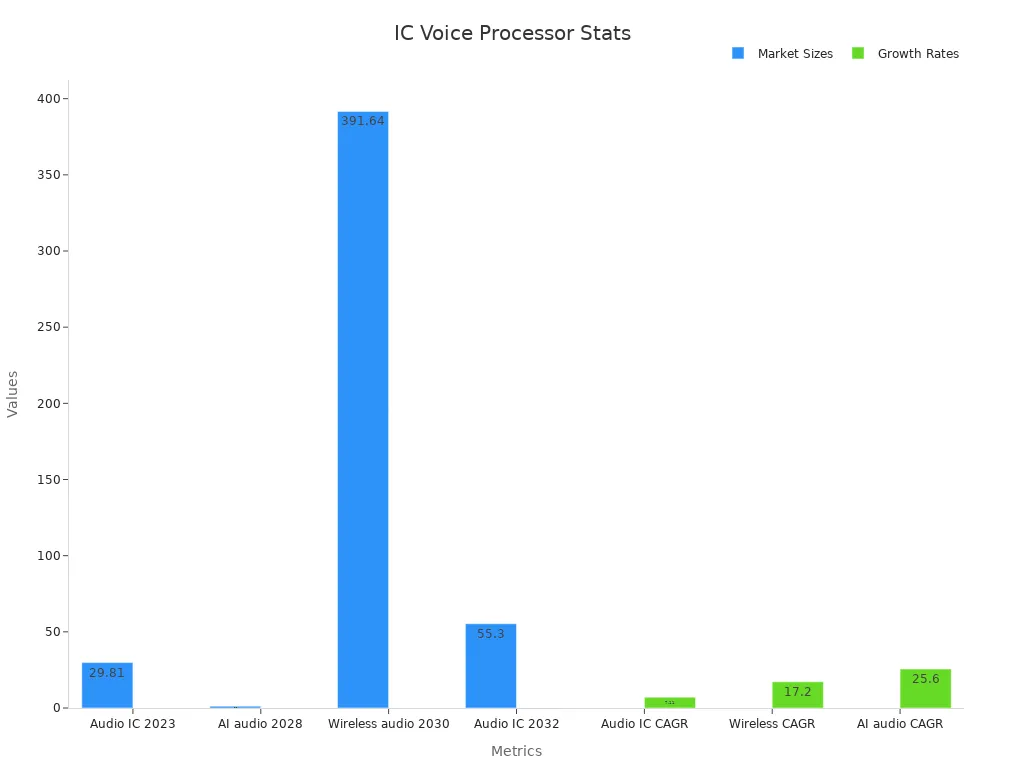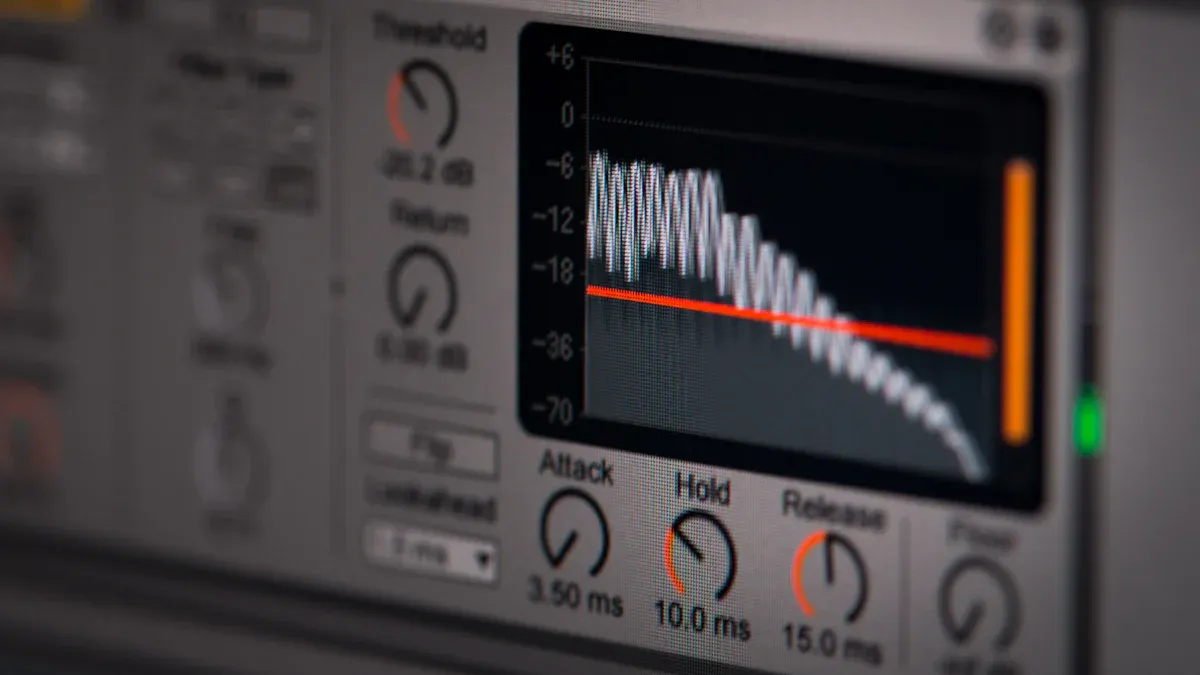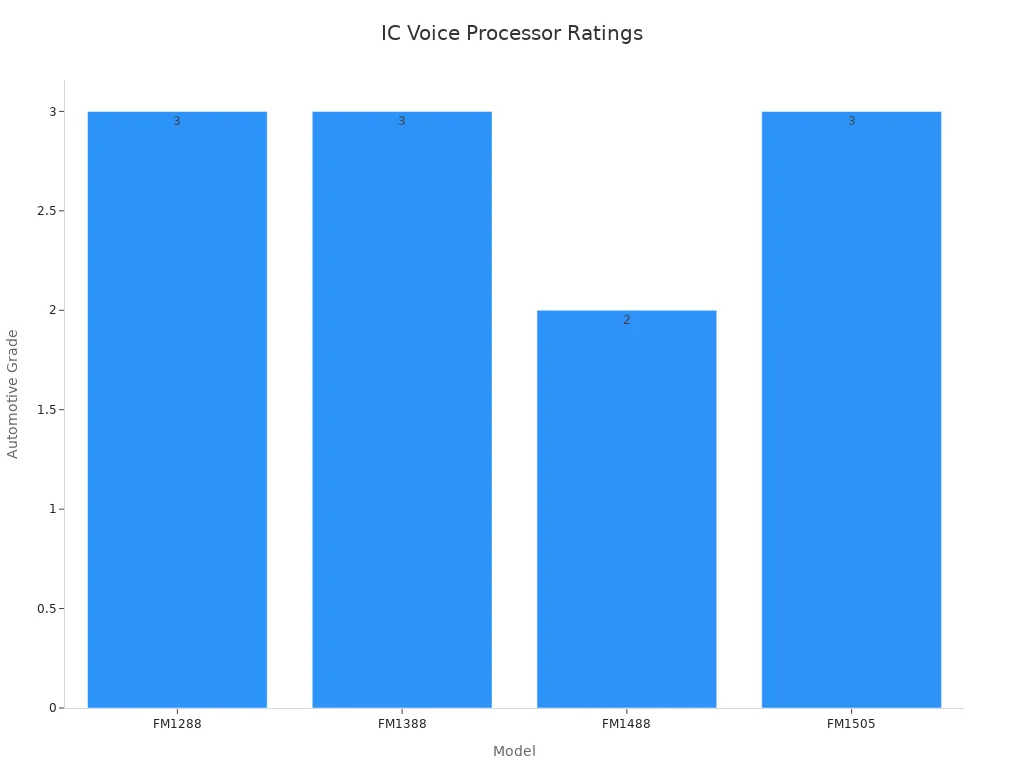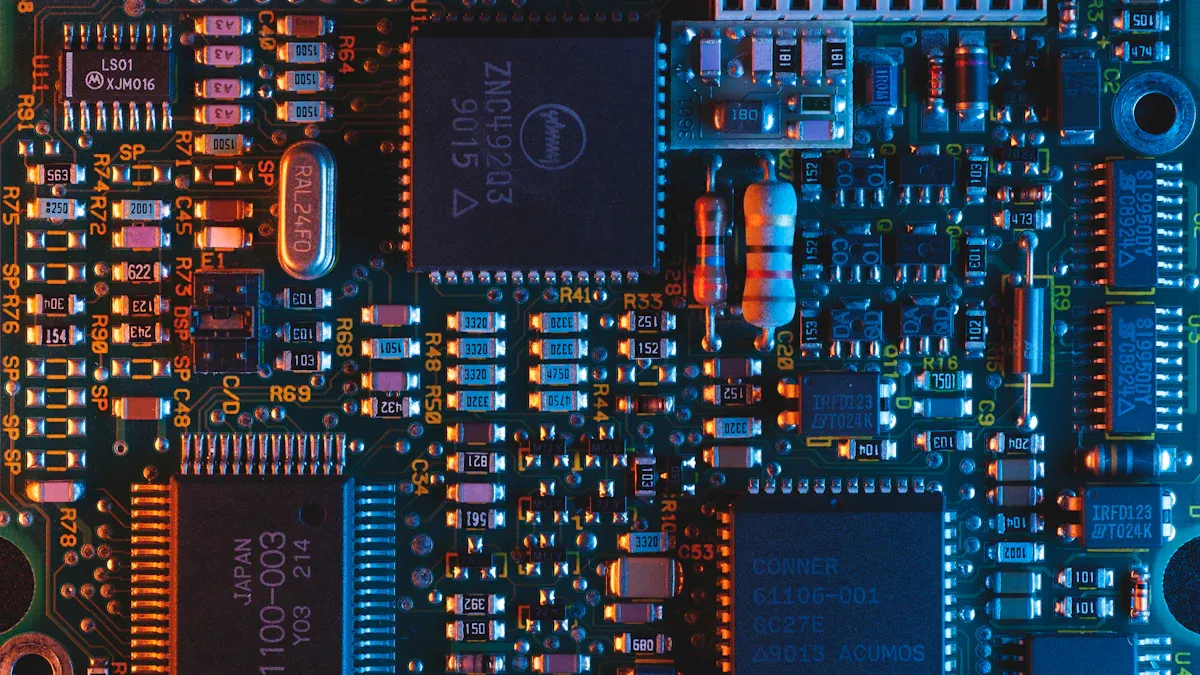What is an IC Voice Processor and How Does It Work

An IC voice processor is a specialized chip that stores, processes, and plays back audio signals in devices. This chip enables clear voice commands and crisp audio playback in products like smart speakers and wireless earbuds. Manufacturers use IC voice processors because they support high-quality audio with features such as 16-bit and 24-bit audio codecs, low power consumption, and flexible storage options. The global audio IC market reached nearly $29.81 billion in 2023 and is projected to grow steadily, reflecting the rising demand for voice-enabled technology.

Key Takeaways
An IC voice processor is a small chip that captures, processes, and plays back sound, making devices like smart speakers and earbuds understand voice commands clearly.
The chip converts analog sounds into digital signals, cleans noise, stores audio, and supports voice recognition to improve sound quality and user experience.
Key parts inside the chip include converters, processors, codecs, memory, and adaptive filters that work together to handle audio tasks efficiently.
IC voice processors come in types like playback, recorder, DSP-based, and integrated SoCs, each designed for specific audio functions and device needs.
These chips power many devices in daily life, from phones and cars to medical tools, helping improve safety, convenience, and accessibility with clear voice control.
IC Voice Processor Basics

What It Is
An IC voice processor is a small chip that helps electronic devices handle sound. This chip takes in voice or audio signals and changes them into a form that the device can use. Many smart devices, such as phones and cars, use this chip to make sure voices sound clear and commands work well. The IC voice processor can work with both simple and complex audio tasks. It often sits at the heart of voice-controlled gadgets.
Tip: Devices with an IC voice processor can understand spoken commands and play back high-quality audio.
Core Functions
The main job of an IC voice processor is to manage audio signals. It does this by performing several important tasks:
Converts analog voice to digital signals: The chip uses an analog-to-digital converter (ADC) to turn real-world sounds into digital data.
Processes audio with digital signal processing (DSP): The chip cleans up the sound, removes noise, and makes voices clearer.
Stores and plays back audio: The chip can save voice messages or sounds in memory and play them back when needed.
Supports voice recognition: Some chips help devices understand spoken words and commands.
Reduces noise and echo: The chip uses special filters to block out background noise and echoes.
Many IC voice processors come with different features and performance levels. The table below shows some popular models and their main specifications:
Model | Package Type | DSP Cores | Key Features | Performance & Test Standards |
|---|---|---|---|---|
FM1288 | LQFP48 (7×7 mm, 0.5mm pitch) | Single DSP + HW accelerators | On-chip ADC/DAC for 2 mics, noise suppression, acoustic echo cancellation, configurable sampling rate, automotive-grade | |
FM1388 | TQFP48 (7×7 mm, 0.5mm pitch) | Single DSP | Multi- and single-mic noise suppression, acoustic echo cancellation with linear/non-linear filtering, voice recognition enhancement, fast convergence, parametric equalization, automatic gain control | VDA/P.1100/P.1110 tests, automotive-grade 3 |
FM1488 | QFN68 (8×8 mm, 0.4mm pitch) | Three DSP cores | Multi-zone voice pickup, stereo echo cancellation, AI engine SSA, voice enhancement, ITU-T P.1100/P.1110/P.1140, CarPlay, GOST R 55531 compliance | Automotive-grade 2 |
FM1505 | TQFP48 (7×7 mm, 0.5mm pitch) | Tensilica Fusion DSP | Advanced acoustic echo cancellation, noise reduction, multi-band voice processing (NB, WB, SWB, FB), hardware AIE for NN algorithms, inter-chip communication, ITU-T P.1100/1110/1120/1140/1150, VDA | Automotive-grade 3 |

Some chips, like the FM1488, use three DSP cores for advanced voice pickup and AI features. Others, such as the FM1288, focus on noise suppression and echo cancellation for cars. These features help devices work well in different environments, from quiet rooms to noisy vehicles.
The IC voice processor stands out because it combines many functions into one chip. This makes devices smarter and more efficient. It also helps save space and power, which is important for portable gadgets.
How It Works
Signal Flow
An IC voice processor manages sound by moving signals through several important steps. The process starts when a microphone picks up a person’s voice as an analog signal. This signal is smooth and continuous, like a wave. Before the chip can work with this sound, it must change it into digital data.
The first step uses an analog-to-digital converter (ADC). The ADC takes the smooth analog signal and samples it at regular intervals. It holds each sample, then turns it into a number that the chip can understand. This process is called quantization. The ADC’s job is to make sure the digital version matches the original sound as closely as possible. High-quality ADCs use many bits to capture more detail, which helps the IC voice processor deliver clear audio.
After the ADC, the digital signal moves to the digital signal processor (DSP). The DSP cleans up the sound by removing noise and unwanted echoes. It can also compress the data using codecs like ADPCM, PCM, or G.729a. These codecs help save space and make it easier to store or send the audio. The DSP can also add effects or adjust the sound to make voices clearer.
If the device needs to play back the sound, the digital signal goes to a digital-to-analog converter (DAC). The DAC changes the digital data back into a smooth analog signal. This signal can then be sent to a speaker or headphones. The DAC must work quickly and accurately to keep the sound natural.
The signal flow inside an IC voice processor also includes checks for errors and quality. Engineers use statistics to measure things like dropped packets, echo levels, and noise. For example, they track how often the buffer overflows or how much echo returns during a call. These measurements help improve the chip’s performance and make sure users hear clear, reliable audio.
Metric Category | Metrics & Descriptions |
|---|---|
Playout Error Statistics | Predictive concealment (ms), Interpolative concealment (ms), Silence concealment (ms), Retroactive memory update (event count), Buffer overflow (errors), Talkspurt endpoint errors |
Level Statistics | Transmission power (0.1 dBm), Transmission mean (0.1 linear PCM), Receive power (0.1 dBm), Receive mean (0.1 linear PCM), Background noise, Echo return loss, ACOM level, Transmit/Receive activity |
Error Statistics | Receive dropped packets, Transmission dropped packets, Receive/Transmission control packets |
ICPIF | Planning Impairment Factor for voice quality prediction |
Note: The signal flow in an IC voice processor follows a clear path: analog input → ADC → DSP → codecs → DAC → analog output. Each step helps keep the sound accurate and clear.
Key Components
Several key parts work together inside an IC voice processor to handle audio tasks. Each component has a special job:
Analog-to-Digital Converter (ADC): This part changes real-world sounds into digital numbers. High-quality ADCs use features like sample-and-hold circuits and high resolution to capture every detail. For example, some ADCs reach a signal-to-noise ratio of 100 dB and keep distortion very low.
Digital Signal Processor (DSP): The DSP acts like the brain of the chip. It runs fast algorithms to filter out noise, cancel echoes, and improve voice quality. Modern DSPs can process up to 450 million instructions per second (MIPS) and work with low latency, which is important for real-time audio.
Codecs: These are special programs or circuits that compress and decompress audio. Codecs like ADPCM, PCM, and G.729a help save memory and make it easier to send audio over networks. Many codecs also include features for noise reduction and echo cancellation.
Digital-to-Analog Converter (DAC): The DAC turns digital audio back into smooth analog signals for playback. High-end DACs offer 24-bit resolution and sample rates up to 192 kHz, which means they can produce very clear and detailed sound.
Memory Storage (ROM): The chip uses memory to store voice data, sound effects, or even voice commands. Some chips use special memory to remember different voices or sounds, which helps with voice recognition.
Adaptive Filters: These filters adjust themselves to changing sounds and environments. For example, if a person moves from a quiet room to a noisy street, the adaptive filter changes its settings to keep the voice clear. Some chips use advanced models that form object memories and use feedback to improve sound quality.
Component | Specification | Value |
|---|---|---|
ADCs | Number | 4 |
ADCs | SNR | 100 dB |
ADCs | THD+N | -86 dB |
DACs | Number | 3 |
DACs | SNR | 122 dB |
DACs | Dynamic Range | 115 dB |
DACs | THD+N | -93 dB |
Sample Rate | Range | 8-192 kHz |
DSP | Power | 450 MIPS |
DSP | Features | Low latency, real-time effects |
Modern IC voice processors combine all these functions into a single chip. This integration saves space and power, making the chip perfect for portable devices. Some chips use advanced frameworks that separate different sounds and form memories of each one. They use feedback to adjust and improve sound quality in real time. Adaptive filters and memory storage work together to help the chip handle changing environments and keep voices clear.
Tip: The combination of high-quality ADCs, powerful DSPs, flexible codecs, and smart adaptive filters makes the IC voice processor reliable and efficient for many audio tasks.
IC Voice Processor Features
Playback and Recording
An IC voice processor allows devices to record and play back audio with high clarity. Users can save voice messages, alarms, or reminders. Many chips support both short and long recordings, depending on the memory size. Devices like smart toys, intercoms, and voice recorders use this feature to store and replay sounds. Some chips offer instant playback, so users hear their voice right after recording. This function helps in language learning tools and voice memos.
Tip: Playback and recording features make devices interactive and user-friendly.
Voice Recognition
Voice recognition lets devices understand spoken commands. The IC voice processor uses special algorithms to pick out words from background noise. Modern chips show strong accuracy, even when the sound quality drops. The table below shows how well these chips perform in different conditions:
Aspect Evaluated | Method/Metric Used | Key Findings |
|---|---|---|
Voice quality distinction accuracy | SVM on MFCC features | Accuracy stays above 80% even with heavy noise, showing strong recognition |
Effect of spectral channels | SVM accuracy across channels | Accuracy ranges from 87% to 90% for most modern devices, only slightly lower than perfect conditions |
Clinical studies confirm that voice recognition features help people with hearing loss and other needs. These chips improve speech understanding and make devices easier to use for everyone.
Noise and Echo Cancellation
Noise and echo cancellation remove unwanted sounds from audio. The IC voice processor uses advanced filters to block out background noise and reduce echoes during calls or recordings. This technology helps users hear voices clearly, even in busy places. Recent tests show that new algorithms improve speech quality and make voices easier to understand. The table below highlights some results:
Measure / Metric | Description | Results Summary |
|---|---|---|
Log-Spectral Distortion (LSD) | Measures speech quality | New methods show lower LSD, meaning better sound |
Short-Time Objective Intelligibility (STOI) | Measures how clear speech is | Higher STOI scores, so speech is easier to understand |
Double-Talk Detection (DTD) Impact | Handles two people talking at once | Better echo cancellation in real-life situations |
Clinical reviews show that these features reduce listening effort and improve satisfaction for users, including those with hearing aids. While long-term studies continue, current results support the value of noise and echo cancellation in modern devices.
Types of IC Voice Processors
Playback ICs
Playback ICs focus on storing and playing back pre-recorded audio. These chips often appear in greeting cards, toys, and alarms. They use simple memory to hold sound clips. When a user presses a button, the chip sends the audio to a speaker. Playback ICs usually have low power needs and work well in small devices. Some models offer multiple sound banks, letting users choose different sounds.
Note: Playback ICs help make products interactive and fun by adding voice or music.
Recorder ICs
Recorder ICs allow devices to capture and store new audio. These chips appear in voice recorders, intercoms, and answering machines. They use built-in memory to save messages or sounds. Users can record, save, and play back their own voices. Recorder ICs often include basic noise reduction to improve sound quality. Some chips support long recording times by using efficient audio compression.
DSP-Based Chips
DSP-based chips use digital signal processing to handle complex audio tasks. These chips can filter noise, cancel echoes, and enhance voice clarity. Arm’s DSP extensions show that DSP-based chips increase efficiency by combining many functions into one processor. This reduces system complexity and cost. Case studies from Yobe and Waves show that DSP-based chips work well in noisy places and consumer audio products. DSPs process audio in real time using special hardware, like fast multiply-accumulate units and high memory bandwidth. These features help DSP-based chips deliver high performance and low power use, making them ideal for portable devices. The BelaSigna 250 chip, for example, combines a programmable DSP core with hardware acceleration, offering high audio quality and low energy use.
Integrated SoCs
Integrated SoCs (System-on-Chip) combine many functions into one chip. These chips handle audio, memory, and wireless tasks together. The Advantest V93000 SoC platform supports many device types, including hi-fi audio and mixed-signal interfaces. Its scalable design allows for high test efficiency and low cost. Direct Probe™ technology improves signal quality during testing, which is important for voice processing. The platform supports high-speed digital and RF testing, making it suitable for complex voice communication SoCs. Many manufacturers use this system to test chips for consumer audio and mobile phones. Integrated SoCs help devices save space and power while supporting advanced features.
Integrated SoCs make it possible for an IC VOICE PROCESSOR to fit into small, smart devices with many features.
Applications

Consumer Devices
Many people use devices with an IC VOICE PROCESSOR every day. These chips help smartphones, smart speakers, and wireless earbuds understand voice commands and play music clearly. Most consumers know about voice-enabled products, and many have tried voice assistants at home. Younger people and families with children use these features more often. People like using voice assistants for simple tasks, such as setting reminders or checking the weather. However, some users worry about privacy and do not use voice features in public. Studies show that people feel excited about shopping with voice assistants, especially when they find the experience fun or helpful. As more devices become smart, the demand for these processors continues to grow.
72% of those familiar have used voice assistants.
Most use happens at home, not in public.
Younger users try new features quickly, but adults use them more often.
Automotive Uses
Car makers use IC voice processors to make driving safer and easier. These chips help drivers control music, navigation, and phone calls without taking their hands off the wheel. Advanced voice processing algorithms, such as Selective Source Pickup and Multi-channel Acoustic Echo Cancelling, improve how well the system hears the driver’s voice, even when the car is noisy. High dynamic range ADCs keep the sound clear, even with loud music or road noise. Some chips, like the Conexant CX20805, combine low-noise microphones and powerful DSPs to recognize commands without needing a button press. Engineers face challenges, such as separating voices from music and handling many speakers at once, but new designs continue to improve performance.
Sector/Application | Key Trends and Drivers | Challenges and Notes |
|---|---|---|
Automotive | More infotainment, better voice control in vehicles | Complex design, higher costs |
Industrial and Medical
Hospitals and factories use IC voice processors to make work faster and safer. In healthcare, voice-based digital assistants help doctors follow best practices during patient rounds. These systems can record conversations, help with electronic health records, and even suggest treatments. Automated transcription and natural language processing allow for better decision-making and less paperwork. In noisy places like factories, these chips help workers use voice commands to control machines or check safety information. Voice processors also support hearing aids and other medical devices, making them smarter and more helpful. New technology captures more data and improves both patient care and worker safety.
Automated transcription reduces manual work.
Ambient intelligence improves patient outcomes and lowers costs.
IC VOICE PROCESSOR chips handle audio and voice signals in many devices, making technology smarter and more interactive. Industries like healthcare, automotive, and consumer electronics use these chips to improve voice control and sound quality.
A review of industry trends shows strong growth in voice-driven technology, with smart speakers and healthcare leading the way.
Market Segment | 2024 Market Size | 2032 Forecast | CAGR (%) | Key Drivers |
|---|---|---|---|---|
Voice Tech in Healthcare | $21.67B | 19.9 | AI, EHR, virtual assistants | |
DSP Audio Processor IC Market | $6.5B (2030) | 8.5 | High-quality audio, AI features | |
Speech & Voice Recognition | $92.08B | 24.7 | AI, cloud, healthcare, BFSI |
Anyone interested in electronics or IoT can benefit from learning how these chips shape the future of smart devices.
FAQ
What devices use IC voice processors?
Many devices use IC voice processors. These include smartphones, smart speakers, hearing aids, cars, and toys. Each device uses the chip to improve sound quality and support voice commands.
How does an IC voice processor help with noise?
The chip uses special filters to block unwanted sounds. It removes background noise and echo. This helps people hear voices clearly, even in busy places.
Can IC voice processors recognize different voices?
Yes, many IC voice processors can tell voices apart. They use advanced algorithms to identify and respond to different speakers. This feature helps with security and personal settings.
Are IC voice processors energy efficient?
Most IC voice processors use very little power. They help devices last longer on a single charge. This makes them ideal for portable gadgets like earbuds and smartwatches.
What is the difference between playback and recorder ICs?
Playback ICs | Recorder ICs |
|---|---|
Play stored sounds | Record new audio |
Used in toys, alarms | Used in recorders, intercoms |
Tip: Choose the right type based on whether the device needs to play or record sound.
See Also
Understanding IC Voice Processors And Their Functionality Explained
Exploring IC Audio Signal Processors And Their Main Characteristics
Defining IC Demodulators And Their Important Operational Role
How Fully Integrated Processors Operate And Their Key Benefits
An Overview Of Programmable Logic Chips And Their Functionality
